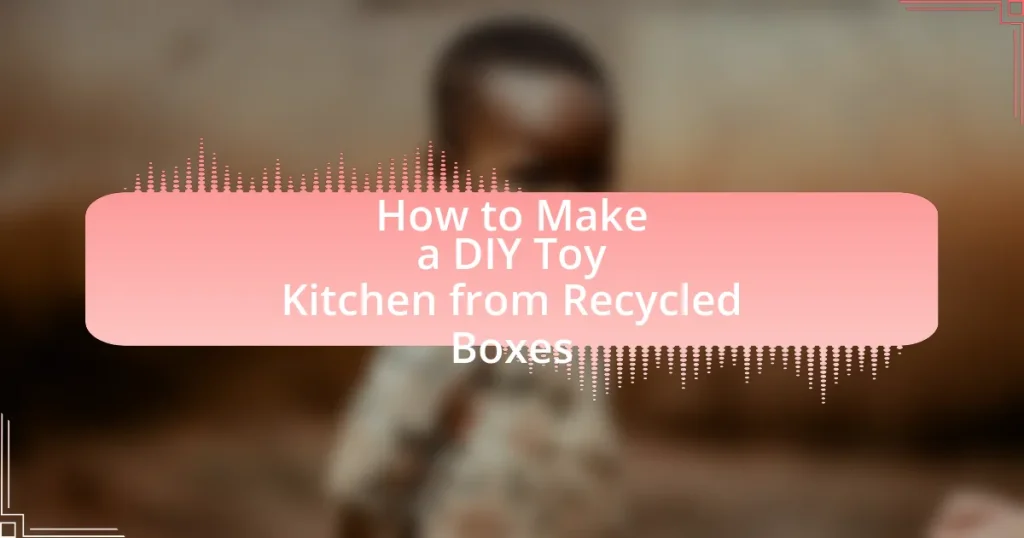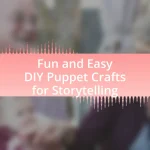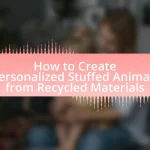A DIY Toy Kitchen made from recycled boxes is an eco-friendly project that allows children to engage in imaginative play while promoting sustainability. This article outlines the process of transforming cardboard boxes into a functional play kitchen, detailing the types of boxes suitable for crafting, preparation steps, and essential tools needed. It highlights the benefits of creating such a kitchen, including fostering creativity, enhancing fine motor skills, and encouraging role-playing scenarios. Additionally, the article provides safety considerations, customization tips, and troubleshooting advice to ensure a successful assembly of the toy kitchen.
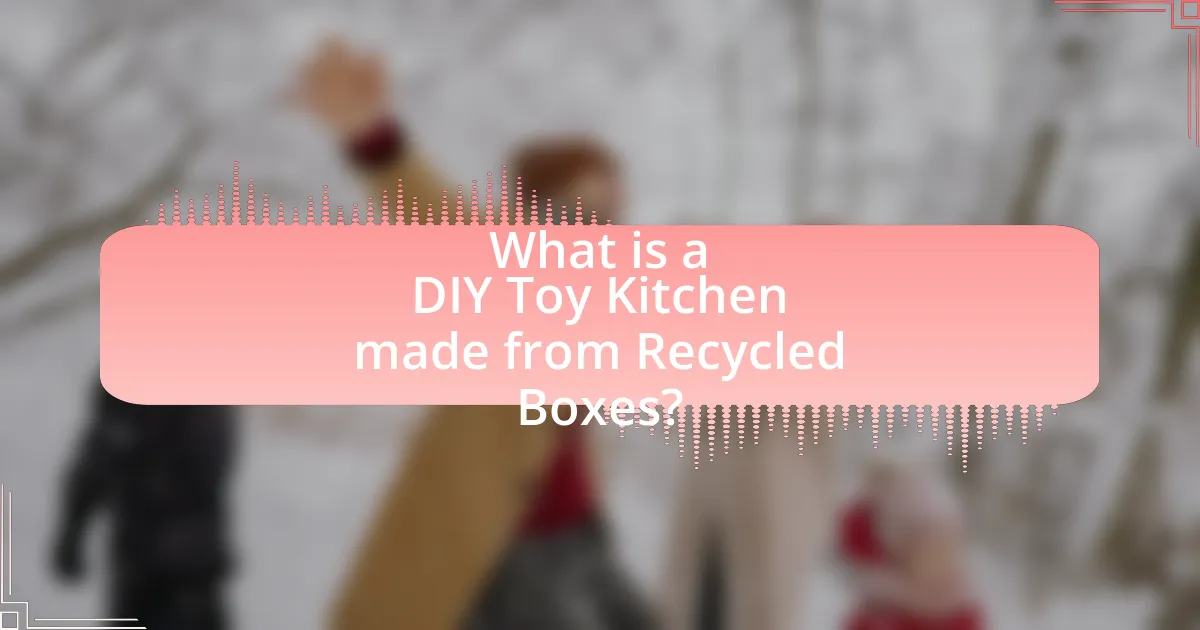
What is a DIY Toy Kitchen made from Recycled Boxes?
A DIY Toy Kitchen made from recycled boxes is a play kitchen constructed using repurposed cardboard or other materials that were previously used for different purposes. This type of toy kitchen allows children to engage in imaginative play while promoting sustainability by utilizing materials that would otherwise contribute to waste. The process typically involves cutting, painting, and assembling the boxes to create features like a stove, sink, and storage areas, making it an eco-friendly and creative project for both children and parents.
How can recycled boxes be transformed into a toy kitchen?
Recycled boxes can be transformed into a toy kitchen by cutting and assembling them into various kitchen components such as a stove, oven, and sink. For instance, a large cardboard box can serve as the main structure, while smaller boxes can be used for the stove top and oven door. Painting the boxes with non-toxic paint and adding details like knobs, handles, and a backsplash can enhance the kitchen’s appearance. This method not only promotes creativity but also supports sustainability by repurposing materials that would otherwise contribute to waste.
What types of boxes are best for creating a toy kitchen?
Cardboard boxes are the best type for creating a toy kitchen. They are lightweight, easy to cut and shape, and can be painted or decorated to resemble kitchen appliances and furniture. Additionally, cardboard is readily available and often free, making it an economical choice for DIY projects. The versatility of cardboard allows for the creation of various kitchen elements, such as cabinets, stoves, and countertops, enhancing imaginative play for children.
How do you prepare the boxes for crafting?
To prepare the boxes for crafting, first, gather clean, sturdy cardboard boxes that are free from any damage or moisture. Next, remove any labels or tape from the boxes to ensure a smooth surface for crafting. After that, cut the boxes into the desired shapes and sizes using a sharp utility knife or scissors, ensuring safety precautions are taken. Finally, reinforce the edges and corners with additional tape or glue if necessary to enhance durability during the crafting process. This method ensures that the boxes are ready for creative use in building a DIY toy kitchen.
What are the benefits of making a DIY Toy Kitchen?
Making a DIY Toy Kitchen offers numerous benefits, including fostering creativity, enhancing fine motor skills, and promoting imaginative play. Engaging in the construction process allows children to express their creativity by designing their own kitchen layout and choosing colors or decorations. This hands-on activity also improves fine motor skills as children manipulate tools and materials, which is essential for their physical development. Furthermore, a DIY Toy Kitchen encourages imaginative play, enabling children to role-play various scenarios, which is crucial for social and cognitive development. Studies show that imaginative play enhances problem-solving skills and emotional intelligence, making the DIY Toy Kitchen a valuable educational tool.
How does creating a toy kitchen encourage imaginative play?
Creating a toy kitchen encourages imaginative play by providing children with a realistic environment to role-play everyday scenarios. This type of play allows children to explore social roles, practice language skills, and develop problem-solving abilities as they mimic cooking, serving, and interacting with others. Research indicates that imaginative play enhances cognitive development, as children engage in storytelling and creative thinking while using the toy kitchen. For example, a study published in the journal “Child Development” found that children who engage in pretend play demonstrate improved executive function skills, which are crucial for planning and decision-making.
What environmental benefits come from using recycled materials?
Using recycled materials significantly reduces environmental impact by conserving natural resources and minimizing waste. Recycling materials like paper, plastic, and metal decreases the need for new raw materials, which in turn lowers energy consumption and greenhouse gas emissions associated with extraction and processing. For instance, recycling one ton of paper can save 17 trees, 7,000 gallons of water, and 4,100 kilowatts of electricity. Additionally, utilizing recycled materials helps divert waste from landfills, reducing pollution and the environmental footprint of waste management.
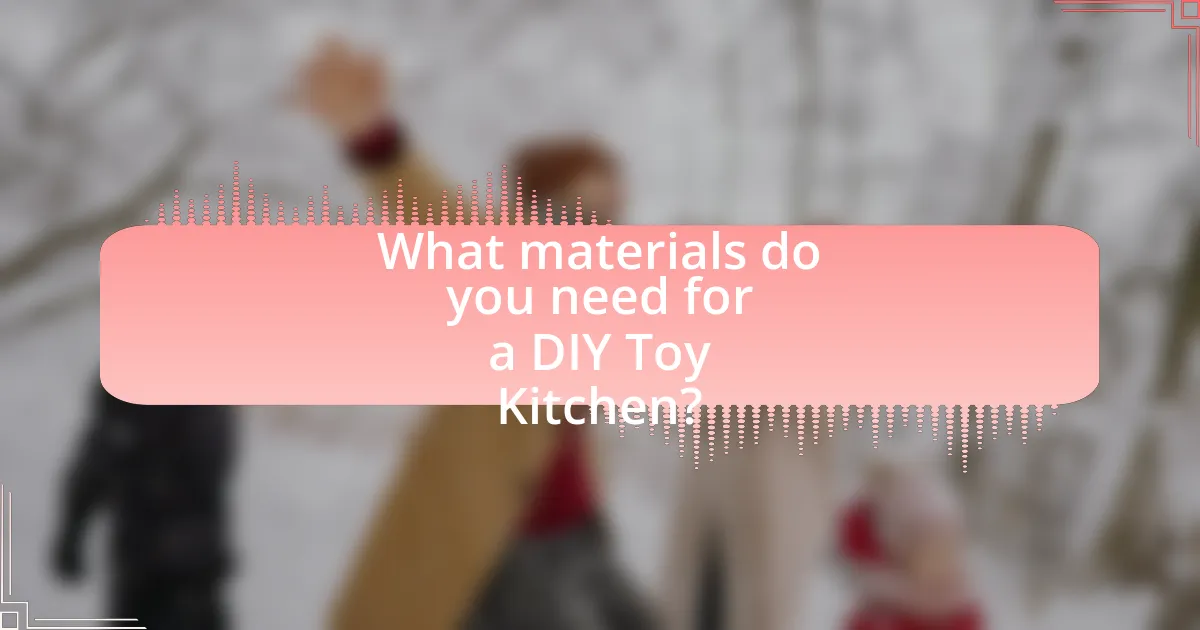
What materials do you need for a DIY Toy Kitchen?
To create a DIY Toy Kitchen, you need cardboard boxes, scissors, paint, glue, and decorative materials such as stickers or fabric. Cardboard boxes serve as the primary structure for the kitchen, while scissors are essential for cutting the boxes into desired shapes. Paint is used to add color and design, and glue helps assemble the pieces together. Decorative materials enhance the visual appeal and can mimic kitchen accessories. These materials are commonly available and cost-effective, making them ideal for a DIY project focused on recycling.
What essential tools are required for the project?
The essential tools required for the project of making a DIY toy kitchen from recycled boxes include scissors, a craft knife, glue, and paint. Scissors are necessary for cutting cardboard and other materials, while a craft knife provides precision for intricate cuts. Glue is essential for assembling the pieces securely, and paint is used to decorate and personalize the kitchen. These tools are commonly used in crafting and DIY projects, ensuring effective and safe construction of the toy kitchen.
How do you safely use scissors and adhesives?
To safely use scissors, hold them by the handle with the blades pointing down and away from your body, ensuring that you cut away from yourself and others. When using adhesives, apply them in a well-ventilated area and avoid direct contact with skin to prevent irritation. These practices minimize the risk of injury and ensure a safe crafting environment.
What alternative materials can enhance the toy kitchen?
Alternative materials that can enhance the toy kitchen include wood, fabric, and metal. Wood provides durability and a realistic appearance, making it suitable for creating sturdy kitchen components. Fabric can be used for curtains, tablecloths, or food items, adding texture and color to the kitchen setup. Metal, such as tin cans or aluminum foil, can simulate pots and pans, enhancing the play experience with a more authentic feel. These materials not only improve the aesthetic appeal but also contribute to a more engaging and imaginative play environment.
What decorative elements can be added to the toy kitchen?
Decorative elements that can be added to a toy kitchen include stickers, paint, fabric curtains, and miniature kitchen accessories. Stickers can enhance the visual appeal by adding colorful designs or themes, while paint can be used to create a vibrant or themed color scheme. Fabric curtains can provide a homey touch, and miniature kitchen accessories like pots, pans, and utensils can add realism. These elements not only beautify the toy kitchen but also encourage imaginative play, making the experience more engaging for children.
How can you create realistic kitchen features with simple materials?
To create realistic kitchen features with simple materials, use cardboard boxes to construct the main structure, paint them to resemble kitchen appliances, and add details like knobs and handles made from bottle caps or buttons. This method allows for an affordable and creative way to mimic real kitchen elements, as cardboard is easily accessible and can be shaped into various forms. For instance, a refrigerator can be made by stacking and cutting boxes, while a stove can be represented by painting a flat box and adding circular cutouts for burners. This approach not only fosters creativity but also promotes recycling, making it an environmentally friendly project.
What are some creative ideas for painting and decorating the kitchen?
Creative ideas for painting and decorating the kitchen include using chalkboard paint for a fun, interactive surface, applying bright colors to cabinets for a vibrant look, and incorporating stencils or decals for personalized designs. Chalkboard paint allows for easy note-taking and drawing, enhancing functionality and creativity. Brightly colored cabinets can transform the kitchen’s atmosphere, making it more inviting. Stencils or decals can add unique patterns or themes, such as fruits or kitchen utensils, which can be particularly appealing in a DIY toy kitchen made from recycled boxes, creating an engaging play environment for children.
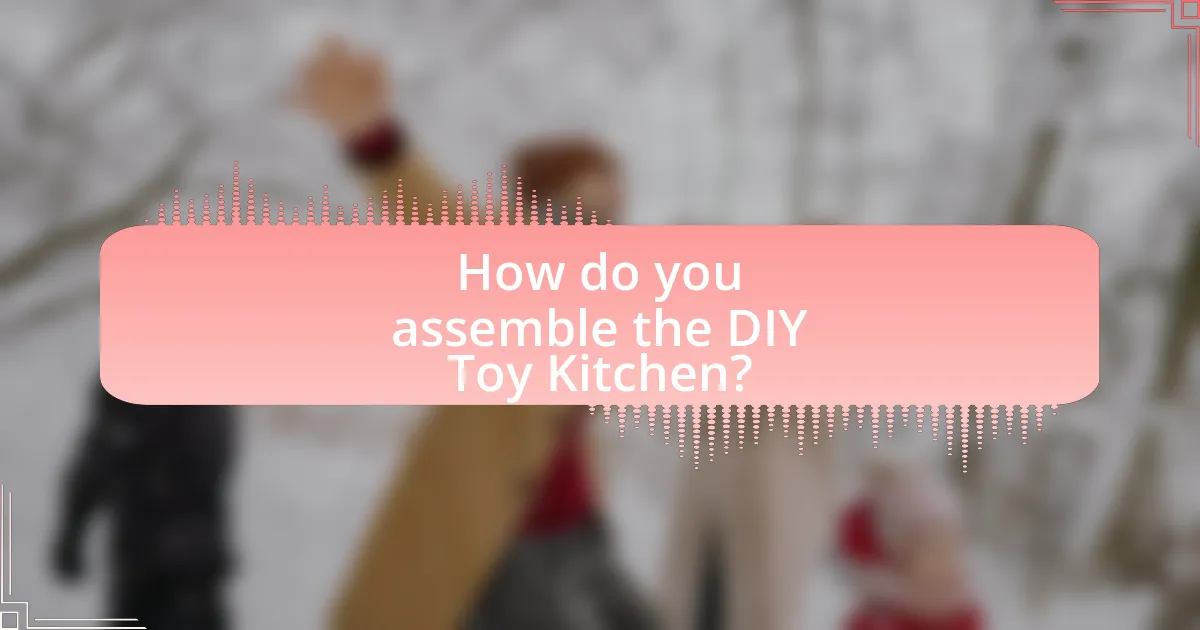
How do you assemble the DIY Toy Kitchen?
To assemble the DIY Toy Kitchen, first gather all necessary materials, including recycled boxes, scissors, tape, and paint. Begin by cutting the boxes to create the kitchen structure, such as the base, countertop, and shelves. Secure the pieces together using tape to form the desired shape of the kitchen. Next, paint the exterior and add details like knobs and burners using additional materials like bottle caps or paper. Finally, allow the paint to dry completely before placing the kitchen in the desired play area. This method utilizes common household items, making it an accessible and eco-friendly project.
What are the step-by-step instructions for building the kitchen?
To build a DIY toy kitchen from recycled boxes, follow these step-by-step instructions:
- Gather materials: Collect cardboard boxes, scissors, tape, paint, and any additional decorative items like stickers or markers.
- Design the layout: Sketch a simple design for the kitchen, including areas for a stove, sink, and countertop.
- Cut the boxes: Use scissors to cut the cardboard boxes into the desired shapes for the stove, sink, and other kitchen components.
- Assemble the structure: Tape the cut pieces together to form the kitchen layout, ensuring stability and strength.
- Paint and decorate: Apply paint to the cardboard surfaces and add decorative elements to enhance the kitchen’s appearance.
- Create accessories: Use smaller boxes or materials to make kitchen accessories like pots, pans, and utensils.
- Final touches: Allow everything to dry and make any necessary adjustments to ensure the kitchen is safe and functional for play.
These instructions provide a clear and practical approach to creating a toy kitchen from recycled materials, promoting creativity and sustainability.
How do you create the base and structure of the kitchen?
To create the base and structure of a DIY toy kitchen from recycled boxes, start by selecting sturdy cardboard boxes that will serve as the foundation. Cut the boxes to the desired dimensions for the kitchen layout, ensuring that the base is wide enough to support the structure and any additional components like shelves or appliances. Secure the boxes together using strong adhesive or tape to form a stable framework. Reinforce the corners and joints for added durability. This method is effective because cardboard is lightweight yet can be made robust with proper assembly techniques.
What techniques can be used to attach different components securely?
Techniques to attach different components securely include using adhesives, screws, nails, and brackets. Adhesives, such as wood glue or hot glue, provide a strong bond for materials like cardboard and wood, ensuring stability in the structure. Screws and nails offer mechanical fastening, which is particularly effective for heavier components, providing durability and resistance to separation. Brackets can be used to reinforce joints and corners, enhancing the overall strength of the assembly. These methods are commonly employed in DIY projects, including constructing a toy kitchen from recycled boxes, where secure attachment is essential for functionality and safety.
What safety considerations should be taken into account?
When making a DIY toy kitchen from recycled boxes, safety considerations include ensuring that all materials used are non-toxic and free from sharp edges. Non-toxic paints and adhesives should be selected to prevent harmful exposure, especially for children. Additionally, any cardboard edges should be smoothed out to avoid cuts or injuries during play. It is also important to supervise children during the construction process to prevent accidents with tools or small parts that could pose choking hazards. These considerations are crucial to create a safe play environment, as children’s safety is paramount in any DIY project involving toys.
How can you ensure the toy kitchen is safe for children to use?
To ensure the toy kitchen is safe for children to use, select non-toxic materials and avoid sharp edges. Non-toxic paints and finishes prevent harmful exposure, while smoothing any rough surfaces reduces the risk of cuts. Additionally, secure all components firmly to prevent tipping or collapsing, which can lead to injuries. Regularly inspect the toy kitchen for wear and tear, as damaged parts can pose safety hazards. Following these guidelines helps create a safe play environment for children.
What materials should be avoided for safety reasons?
Materials that should be avoided for safety reasons when making a DIY toy kitchen from recycled boxes include toxic substances like untreated wood, which can splinter and cause injury, and materials containing lead, such as old paint or certain plastics, which pose health risks. Additionally, sharp objects like metal edges or staples should be eliminated to prevent cuts. Using non-toxic adhesives and paints is crucial, as some chemicals can be harmful if ingested or inhaled.
What are some tips for customizing your DIY Toy Kitchen?
To customize your DIY Toy Kitchen, consider using paint to add vibrant colors and designs that reflect your child’s preferences. Incorporating functional elements like knobs, handles, and shelves can enhance realism and playability. Additionally, using recycled materials such as cardboard, plastic containers, and fabric scraps allows for unique textures and shapes, making the kitchen more visually appealing. Personalizing the kitchen with your child’s name or favorite characters can also create a special connection. These methods not only improve aesthetics but also encourage imaginative play, as children engage more with customized environments.
How can you personalize the kitchen to reflect your child’s preferences?
To personalize the kitchen and reflect your child’s preferences, incorporate their favorite colors, themes, and play items into the design. For example, if your child loves a specific cartoon character, use stickers or paint in those colors to decorate the kitchen. Additionally, include play utensils and food items that align with their interests, such as fruits, vegetables, or specific dishes they enjoy. Research shows that children engage more with toys that reflect their personal interests, enhancing their imaginative play and learning experiences.
What are some common troubleshooting tips during the assembly process?
Common troubleshooting tips during the assembly process of a DIY toy kitchen from recycled boxes include ensuring all materials are clean and dry before starting, verifying that all pieces fit together correctly, and using appropriate adhesives or fasteners for stability. Additionally, if parts do not align, check for any obstructions or miscalculations in measurements. If the structure feels unstable, reinforce joints with extra tape or glue. These practices help prevent common assembly issues and ensure a successful build.
